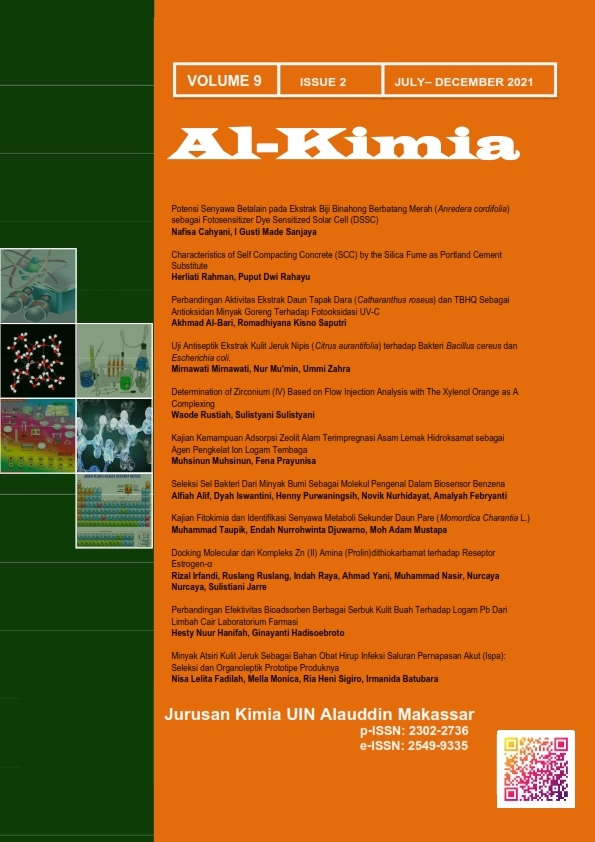Uji Antiseptik Ekstrak Kulit Jeruk Nipis (Citrus aurantifolia) terhadap Bakteri Bacillus cereus dan Escherichia coli
Abstrak
Indonesia is one of the countries with the fourth largest natural wealth in the world. The magnitude of the natural potential provides a great opportunity for scientists to develop it as a useful product for society. One of the medicinal plants that can be used is lime (C. aurantifolia). The purpose of this study was to determine the inhibition of lime peel extract (Citrus aurantifolia) against Bacillus cereus, Escherichia coli and mold bacteria using the coloni counter method. This research includes the extraction process of the maceration method then the extract obtained is tested for bacterial analysis using a colony counter. Based on the results of the research conducted, it can be concluded that lime peel extract (C. aurantifolia) has the ability to inhibit the growth of B. cereus and E.coli bacteria, respectively 0 APM/g and <3.0 APM/g. This is because there are bioactive compounds such as -pinene and D-limonene in lime peel extract (C. aurantifolia).##plugins.generic.usageStats.downloads##
Referensi
Al-Aamri Maha S, Nour M. Al-Abousi, Sausan S. Al-Jabri, Tanveer Alam, Shah A. Khan, 2018. Chemical Composition and in-vitro Antooxidant and Antomicrobial Activity of the Essential Oil of Citrus aurantifolia L. leaves Grown in Eastern Oman. Journal of Taibah University Medical Sciences. 13(2): 108-112.
Al-Snafi AE, Thuwaini MM. 2017. Arabian Medical Plants with Hepatoprotective Activity.
Apraj V, Thakur ND, Bhagwat A, Mallya R, Sawant L, Pandita N, 2011. Pharmacognostic and Phytochemical Evaluation of Citrus aurantifolia (Christm) Swingle Peel. Pharmacogenomics J. 3: 70-76.
Ballistreri G, Fabroni S, Romeo FV, Timpanaro N, Amenta M, Rapisarda P, 2019. Anthocyanins and Other Polyphenols in Citrus Genus : Biosynthesis, Chemical Profile, and Biological Activity. In : Polyphenols in Plants. Elsevier. 191-215.
Chen MH, Yang K M, Huang TC, Wu M L, 2017. Traditional Small-Size Citrus from Taiwan: Essesntial Oils, bioactive Compounds and Antioxidant Capacity. Medicine. 4: 28.
Delgado A M, Issaoui M, Chemmen N, 2019. Analysis of Main and Healthy Phenolic Compounds in Foods. J. AOAC Int. 102: 1356-1364.
Dosoky N, Setzer W, 2018. Biological Activities and Safety of Citrus spp. Essential Oils. Int. J. Mol. Sci. 19, 1996.
Fattore M, Montesano D, Pagano E, Teta R, Borrelli F, Mangoni A, Albrizio S, 2016. Carotenoid and Flavonoid Profile and Antioxidant Activity in “Pomodorino Vesuviano” tomatoes. J. Food Compost. Anal. 53: 61-68.
Hafizah, Indria, 2015. Uji Aktivitas Antibakteri Ekstrak Metanol Rumput Laut (Eucheuma sp) pada berbagai Tingkat Konsentrasi terhadap Pertumbuhan Bakteri Escherichia coli dan Staphylococcus aureus. FK UHO. 64-70.
Ladaniya MS. 2008. Nutritive and Medical Value of Citrus Fruits. In : Citrus Fruit. Elsevier. 501-14.
Lu X, Zhao S, Ning Z, Zeng H, Shu Y, Tao O, Xiao C, Lu C , Liu Y, 2015. Citrus Fruits as a tresure Trove of Active Natural Metabolites that Potentially Provide Benefits for Human Health. Chem Cent. 9: 68.
Rafiq S, Kaul R, Sofi S A, Bashir N, Nazir F, Nayik G A. 2018. Citrus Peel as A Source of Functional Ingredient : A Review. J Saudi Soc. Agric. Sci. 17: 351-358.
Seko Mami H, Alan Ch. Sabuna, James Ngginak, 2021. Ekstrak Etanol Daun Ajeran Antibakteri terhadap Staphylococcus aureus. Jurnal Biosains. 7(1): (1-9).
Toy, Torar, 2015. Uji Daya Hambat Ekstrak Rumput Laut Gracilaria sp terhadap Pertumbuhan Bakteri Staphylococcus aureus. e-Gigi.3(1): 153-159.
Wijaya Raden Candra, Ervita Lusiana Utari, Yudianingsih, 2015. Perancangan Alat Perhitungan Bakteri. Jurnal Teknologi Informasi, Vol. X. No. 29.
Authors who publish with this journal agree to the following terms:
1) Authors retain copyright and grant the journal right of first publication with the work simultaneously licensed under a Creative Commons Attribution License that allows others to share the work with an acknowledgement of the work's authorship and initial publication in this journal.
2) Authors are able to enter into separate, additional contractual arrangements for the non-exclusive distribution of the journal's published version of the work (e.g., post it to an institutional repository or publish it in a book), with an acknowledgement of its initial publication in this journal.
3)Authors are permitted and encouraged to post their work online (e.g., in institutional repositories or on their website) prior to and during the submission process, as it can lead to productive exchanges, as well as earlier and greater citation of published work (See The Effect of Open Access).


